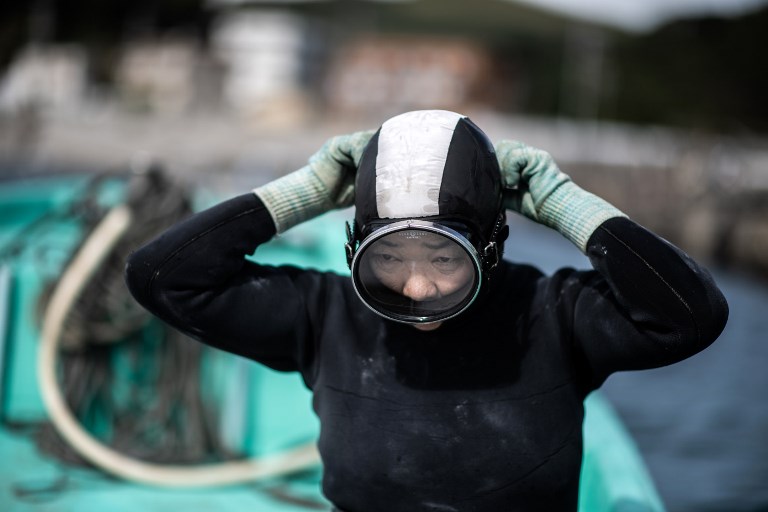
by Anne BEADE
Agence France Presse
TOKYO, Japan (AFP) — A group of Japanese grannies emerges from a boat returning to shore. Clad in black wetsuits and bubbling with energy, they are part of a dwindling community of “ama” — freediving fisherwomen.
As they compare the hauls of shellfish they have gathered, the women — who range from 60 to 80 years old — could be mistaken for teenagers underneath the water, gliding gracefully in the dark depths of the Pacific.
“I really feel like I am a mermaid among the fish, it’s a fantastic sensation,” says a beaming Hideko Koguchi, who works as an ama in the coastal town of Toba.
Back on shore, she kneels and counts the turban shells — a type of sea snail — gathered by the group.
Dressed in her full ama outfit — a mask that covers her eyes and nose, flippers and a black wetsuit that replaced a white version worn until the 1960s — Koguchi sheds the weight of her years.
She has been an ama for three decades, and says proudly that she hopes to be diving “for another 20 years”.
During the diving season, which lasts for 10 months a year, the local fishing association scrutinizes weather forecasts and information on marine stocks each day, before issuing a call for the women from loudspeakers.
Each ama — which means “woman of the sea” — has only rudimentary equipment: a buoyant ring to signal her presence at the surface while she dives, and a net to hold her haul.
Out at sea, the women set up their rings and then dip beneath the surface, sometimes holding their breath for more than a minute. They tirelessly resurface and dive over and over, dozens of times a session.
‘No longer viable’
Only 2,000 ama are left across Japan, down from more than 12,000 in the 1930s, according to records kept by a marine museum in Toba.
The profession still exists in South Korea, where the divers are known as haenyo, but their numbers are also shrinking.
Historical artefacts suggest the tradition in Japan dates back “at least 3,000 years,” said Shuzo Kogure, an ama specialist and researcher at the Tokyo University of Marine Science and Technology.
And while the profession has never been restricted to women, it is the female ama who have attracted the most attention.
Old photos and postcards depict the divers fishing topless, a practice that ended in the 20th century but remains associated with the ama and the idea of them as “exotic objects of fantasy”, said Kogure.
But cliches aside, the women have long worked hard to feed their families in isolated rural regions where other types of jobs were limited.
“In the old days, young women would become ama when they left middle school,” like a rite of passage, explained Sakichi Okuda, director of the local fishing cooperative.
Like Koguchi and her older sister, who dive together, they usually learned the basics from a relative at a young age.
The sisters are part of an ama lineage that stretches back through their mother and grandmother, but their skills will not be passed on to the next generation — their children have left for the city, in search of more stable jobs.
Okuda admits that “it is no longer viable to take on this job.”
To preserve the culture, “we have to answer the question of how we can increase the revenue of these divers.”
‘Moments of freedom’
The women, some of whom even walk with their backs bent over with age, acknowledge the work is poorly paid and dangerous.
“Of course I would love the kids to take over, but I know that being an ama diver is a difficult job and I don’t recommend it, even to my own children,” says Koguchi’s sister Michiko Hashimoto.
She sits warming herself up around a fire in a the hut where the women gather after fishing to catch up and recharge.
“If we want to protect and transmit the values of the ama, their way of life, we have to open the door to strangers, beyond the tradition of passing things through the family,” said Kogure.
“If we can accept that change, then the future need not be so dark,” the expert said, adding that the government and local authorities should offer financial support to the divers.
In the neighbouring village of Osatsu, young recruits are eagerly welcomed.
Ayami Nagata, a 39-year-old mother of five, began her ama training last year, following in the footsteps of her grandmother.
“I don’t know how to swim, but I am practising in shallow areas to start with,” she said.
She isn’t joining the profession for the money: each catch goes for only around 10,000 yen ($88).
For Nagata it’s about escape: “these moments of freedom far from the family.”
© Agence France-Presse







